Ecommerce site owners. Your site visitors want to give you money. They’re visiting your eCommerce shop because they have an interest in your company and its offerings. Your site visitors are so motivated, in fact, that they may even have their credit card already in their hands! This sale is yours to lose.
That’s the good news.
The bad news? Well, you know how it is. The Internet is full of distractions. From cat videos to social media notifications to browsers that let you keep dozens of tabs open at a time — there are a lot of things competing for your customers’ eyeballs. Your eCommerce descriptions need to capture your customers’ attention quickly — or you’ll lose them forever.
Here we are going to offer some tips – with successful real-world examples – to help steer you in the right direction. We’ll discuss best practices for writing eCommerce descriptions that sell. We’ll show you how to subtly and not-so-subtly signal the key features and benefits of your products … without veering into that off-putting heavy sales tone. How to bring your brand to life with stories, not statistics.
Tip 1: Write For, Not At, Your Customers
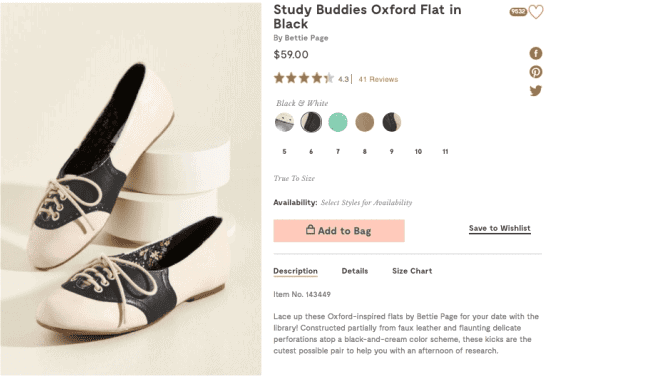
Vintage-inspired women’s clothing retailer ModCloth is all about “real people.” The company — owned by Jet.com since 2017, and now Walmart since they purchased Jet — has made a mission of not using Photoshop to enhance the physical features of its models and offering fashions for ‘real women’.
Notice how the description for these casual shoes describes key features and benefits of the product (“constructed partially from faux leather and flaunting delicate perforations atop a black-and-cream color scheme”)? The florid writing style helps ensure that the blurb reads cleanly while subtly selling the uniqueness of the shoes.
More importantly — this description does a fantastic job of speaking to customers in a language they understand while also including SEO keywords they may have been searching for.
A quick scan of the description shows a powerful sprinkling of keywords — “Oxford-inspired,” “Bettie Page” (it’s the shoe brand, but the name itself evokes a wonderful image that’s totally on-target)
This is a description that knows exactly who its target customers are. That’s why it feels like this blurb is written to a friend, not to a customer.
Tip 2: Clearly Define Your Buyer Persona
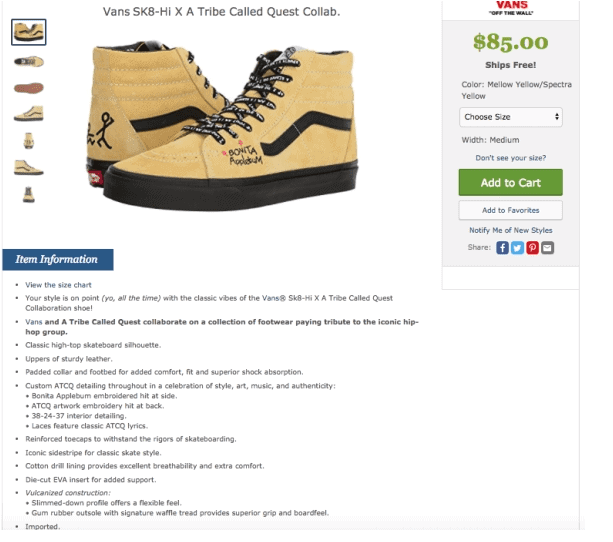
Online shoe retailer Zappos is famous for its commitment to customer service. As the legend goes — Zappos call centre employees don’t have scripts, and one call reportedly went on for 10 ½ hours!
Notice how the company uses slang and humor to speak directly to its customer in a non-pretentious tone. Furthermore, the blurb begins with a compliment that’s specific enough to be flattering, yet general enough to feel universal — “Your style is on point (yo, all the time)…”
It’s important to include factual details and technical specs for credibility and SEO purposes. Zappos keeps it fresh with in-the-know terminology (“superior grip and board feel”; “signature wave tread”) — meaning that this listing builds trust immediately with the consumer and with search engines.
Tip 3: Create a Comprehensive List of Benefits and Features That’s Memorable
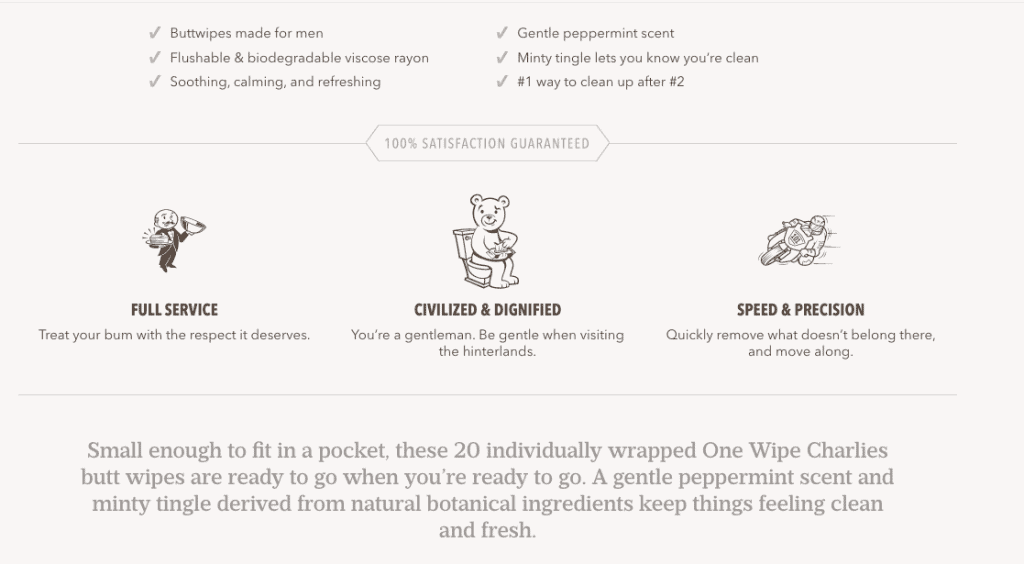
Dollar Shave Club went from scrappy indie startup to overnight icon with its March 2012 YouTube promo video, “Our Blades Are F***ing Great.” The off-the-cuff, irreverent style was a hit with customers looking for a no-B.S. shaving solution. The industry took notice, too: in 2016, Unilever acquired the company for a reported $1 billion.4
DSC maintains that legacy of silliness and memorability with its online copy. Check out this listing for its “Butt Wipes” — a new vertical that the company entered recently. Notice anything? The sentences are short—lots of “you” in there. And while the description contains plenty of colorful imagery and words that paint a picture — there are also some great memorable phrases (“1 way to clean up after 2”) to drive the point home.
Tip 4: Use a Scannable Format
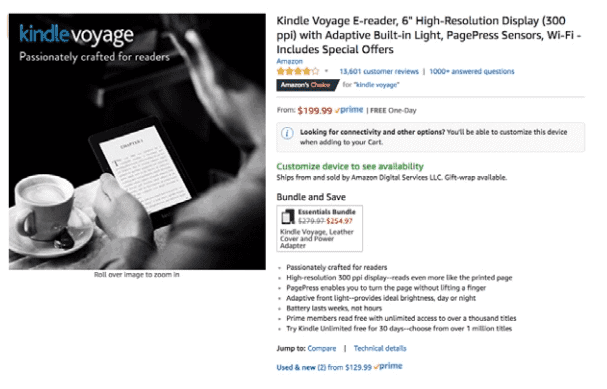
For the past 15 years, the Amazon Kindle has been a flagship product in the eBook space. Its very name came about because the product developers wanted to suggest the explosive excitement of reading.
Interestingly, Amazon takes the same tack for its Kindle listing as it does for its other products. By mixing in a combination of stats and facts with eye-catching words like “free” and “unlimited” — the eCommerce giant creates a product listing that’s easily scannable and info-packed. Hey, you don’t get to be the largest Internet retailer in the world by using fluffy descriptions when they are not needed.
Tip 5: Fragments Can Be Your Friends
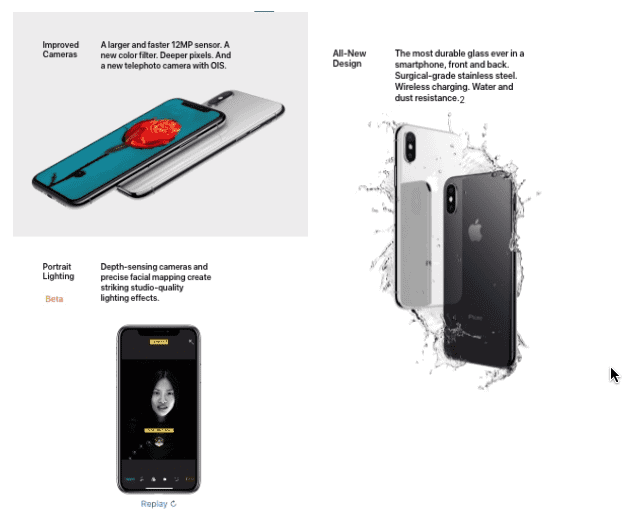
Ah, Apple.
The Cupertino-based consumer electronics behemoth has been pushing the boundaries with its advertising since its groundbreaking “Think Different” campaign in the late ‘90s and early ‘00s.
It isn’t surprising, then, that the retailer has done so well with its short and punchy copywriting style. Think of it as writing to make your grammar teacher fume. This description is full of fragments, sentences that start with conjunctions and hip acronyms — a laundry list of proper English no-nos!
But, it all adds up to make this blurb feel memorable and urgent. Even just the experience of reading this description makes you feel energized — a feeling that Apple’s artistic customer base really connects with.
Tip 6: Create Memorable Soundbites

Negative Underwear’s mission statement is as skimpy as its garments. “We’re firm believers that less is more,” it states unapologetically.
This eCommerce startup believes in quality over quantity, and that’s why every single one of the words in its short description packs a punch. Negative plays on its own irreverence with silly imagery — “whipped cream cloud” and tongue-in-cheek boasts –“unscientifically proven to help you sleep better.” are all designed to make you laugh, but also to stick in your head. Its copy is memorable, unique and brand-defining in an industry dominated by companies far larger than it.
Tip 7: Be Specific and Aspirational
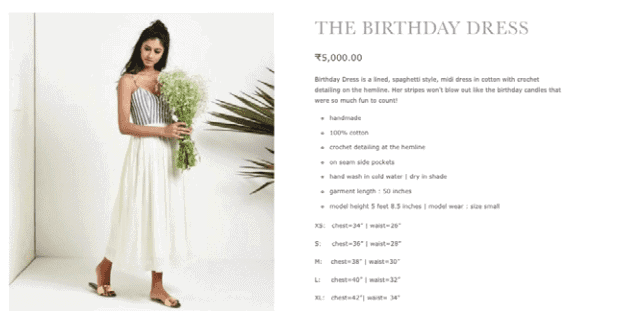
Kharakapas is a lifestyle and luxury eCommerce retailer — meaning, among other things, that it can easily charge a premium for doing things like “deriving inspiration from local artisans” and “preserving and honoring Indian crafts through [their] work.”
It’s a sweet spot for sure: the designs are spare and minimalist, but the feel-good factor is high. That’s why Kharakapas’ product descriptions are evocative and aspirational. From their titles — things like “The Birthday Dress,” “It’s Pouring Elephants,” “Rainbow Eater,” etc. — to their care instructions — these listings paint a vivid picture of exactly the type of customer who wears these clothes.
The result? By niching down with hyper-specific descriptions, Kharakapas actually broadens the appeal of its products drastically.
Tip 8: Add Some Technical Details for Comparison Shoppers

Product descriptions should be just like skirts: long enough to cover the subject, but short enough to generate conversation. For ColourPop, a mid-range cosmetic e-tailer offering affordably priced hip lipsticks and eye makeup, the descriptions need to hit on all of the company’s brand values without appearing to ramble.
ColourPop markets its products to several, not-necessarily-overlapping customer target groups — fashion-forward people, cost-conscious consumers and customers who care about keeping cosmetics cruelty-free.
So, this description sets up subtle comparisons and highlights value. It talks about what the company could have done — “We didn’t just give you neutrals” — and reiterates superiority over competitors’ products without coming off as mean or vicious.
Tip 9: Tell A Story
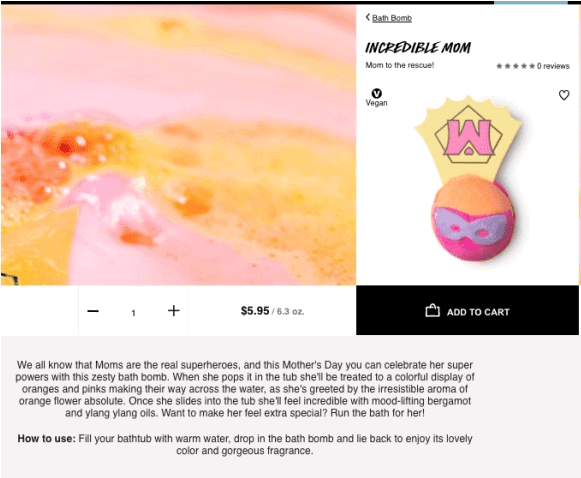
Lush — a UK-based natural hair and beauty retailer — has made great inroads into the international eCommerce marketplace by honing a very specific and appealing brand voice.
Brilliant colors. Flashy labels. Irresistible propositions.
Those are just a few of the techniques that Lush uses in its eCommerce descriptions to keep your eyes moving all over its product pages — and your fingers hurtling toward that “Add to Cart” button. And the smartest thing Lush does? It uses its product descriptions to tell stories where you — the reader and prospective customer — are the hero.
For example, this Mother’s Day-themed bath bomb is “irresistible”, and “incredible” — and when presented it to a special mom in your life, you’ll be honoring not only her superpowers … but your own, too, or at least that’s the way this ‘story’ goes.
Tip 10: Be Funny
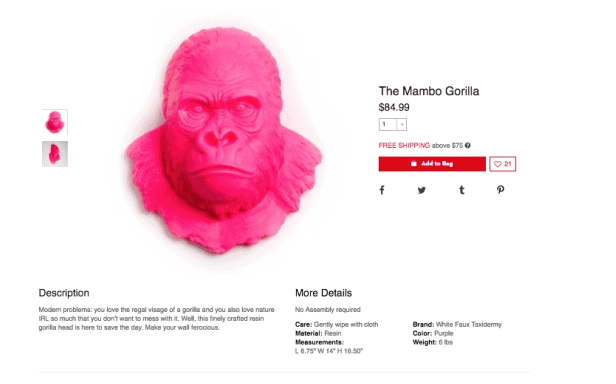
Nobody has ever opened a Web browser with the thought: “I really need a hot pink gorilla head for my wall.” And yet, Fab — an eCommerce company selling cheeky homewares and outrageous novelty gifts — has been able to move this and similarly frivolous-sounding products, mainly on the power of great eCommerce product listings.
Let’s examine the skill on display in this one. There’s sarcasm (“Modern problems: You love the regal visage of a gorilla …”). There are punchy acronyms (“you also love nature IRL”). Finally, there’s an abbreviated overall style that makes this description feel urgent and fun. In place of the usual calls to action — “Try one now,” “Grab one for a friend,” etc. — this listing boldly urges the reader to “Make your wall ferocious.”
Humor is an excellent sales tool. That fact is no more apparent than on a listing for an $85 pink resin gorilla head. That we may or may not want to purchase as a result of researching this article.
Need help with your eCommerce listings? The Pearl Lemon content team are both skilled copywriters and SEO experts. Give us a call to discuss how they can help you create product listings that don’t just sell more but help define your brand and make it memorable too.








